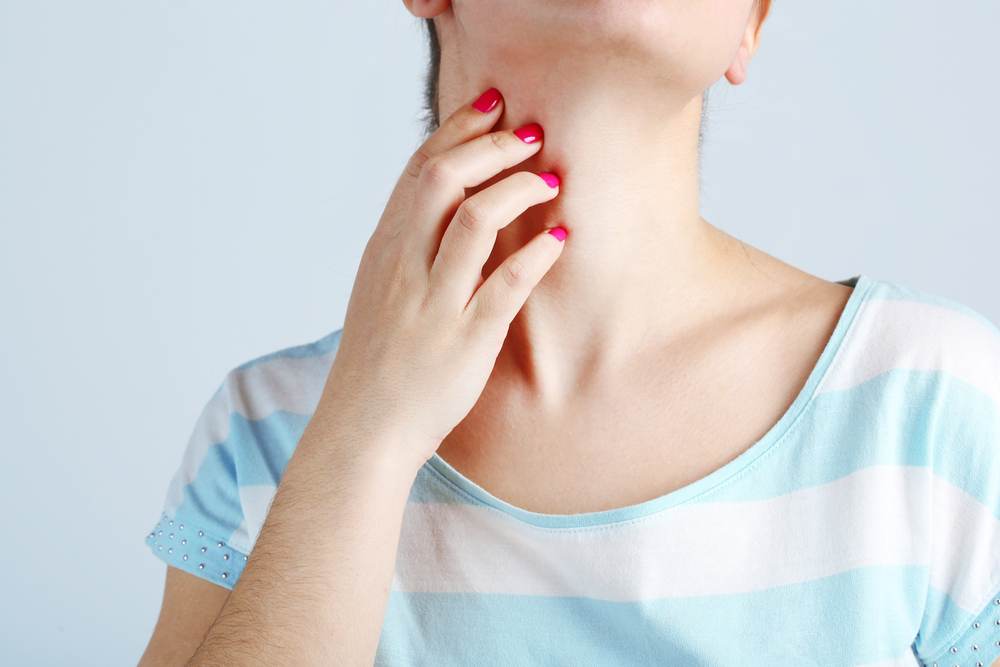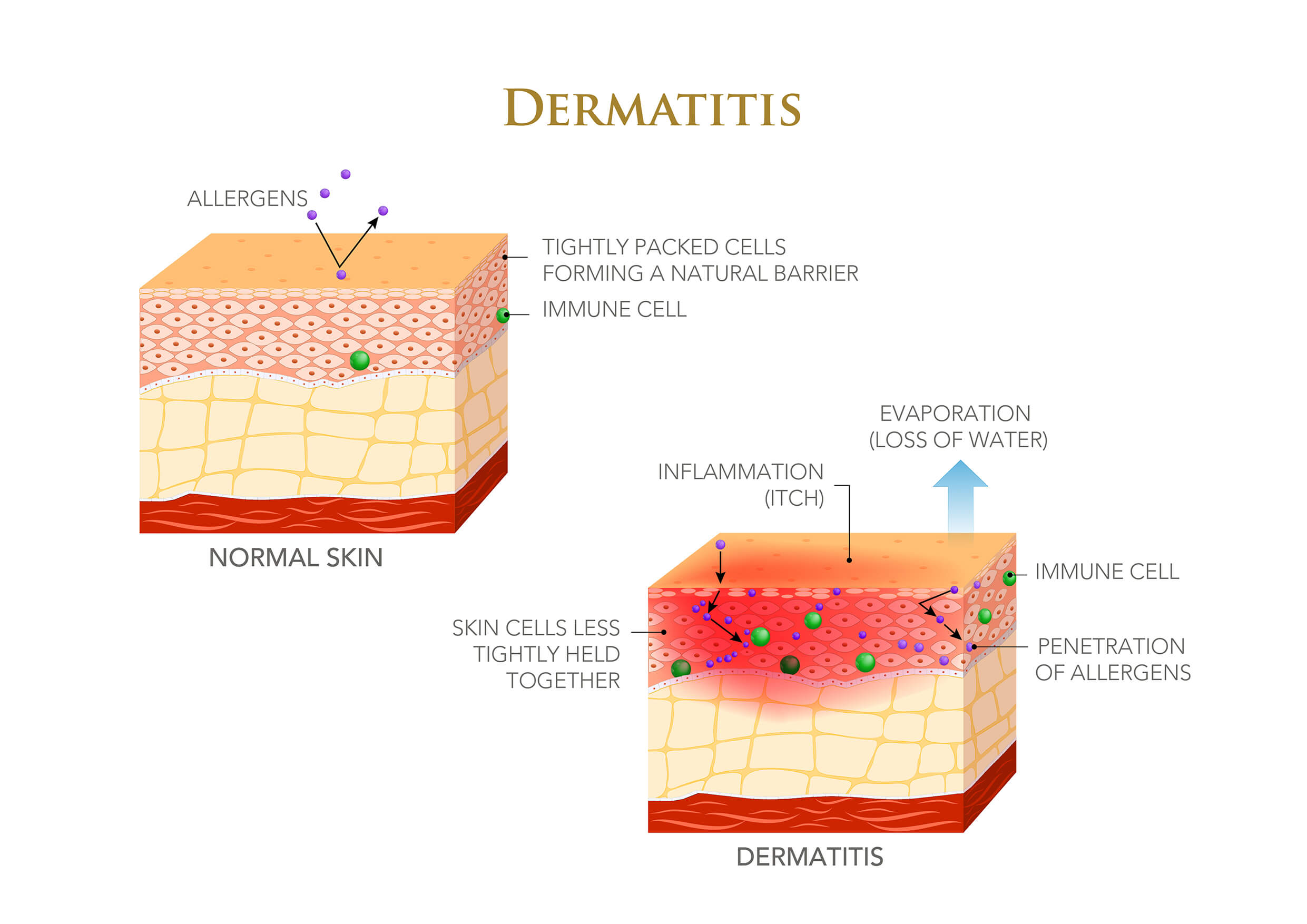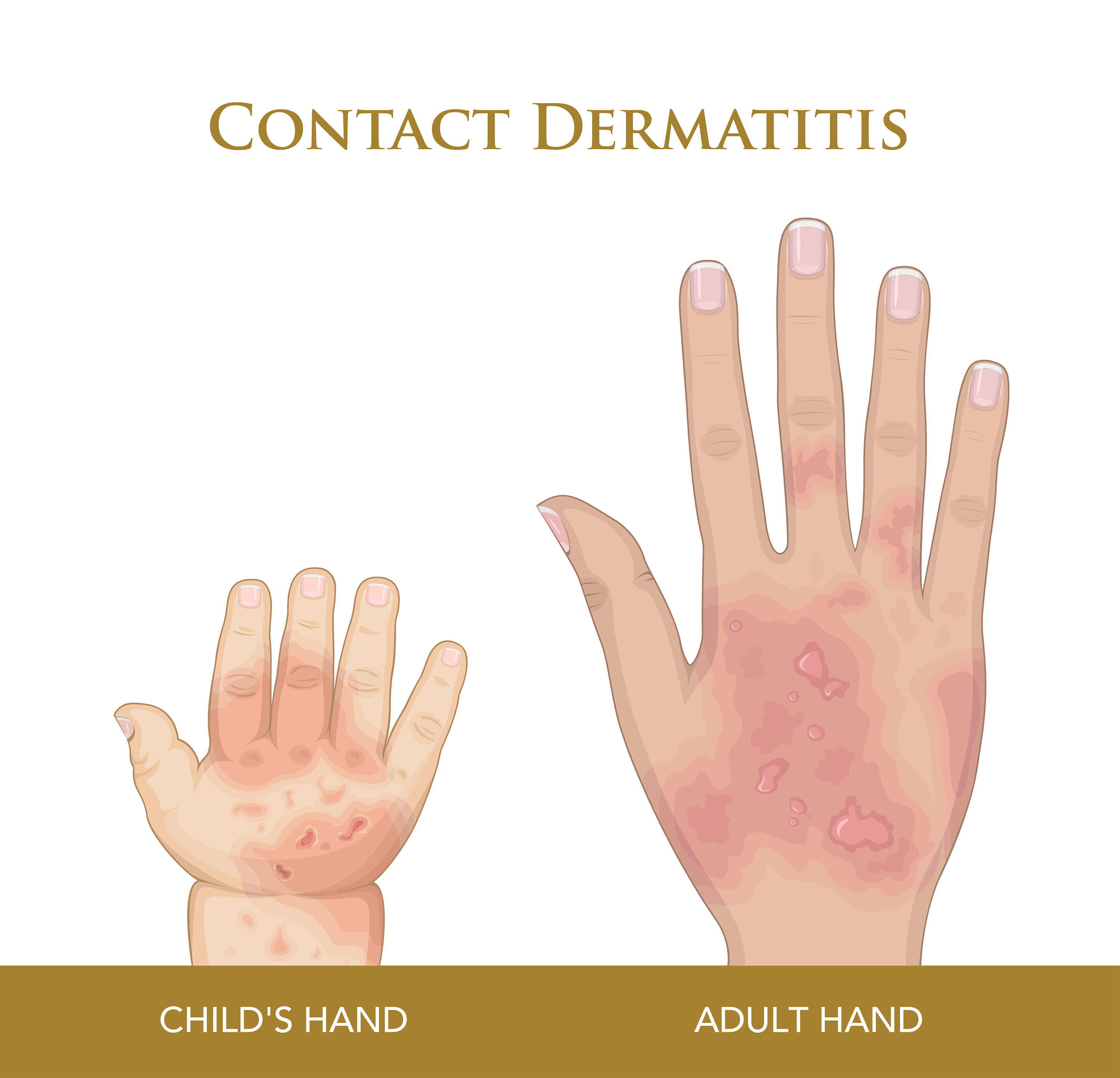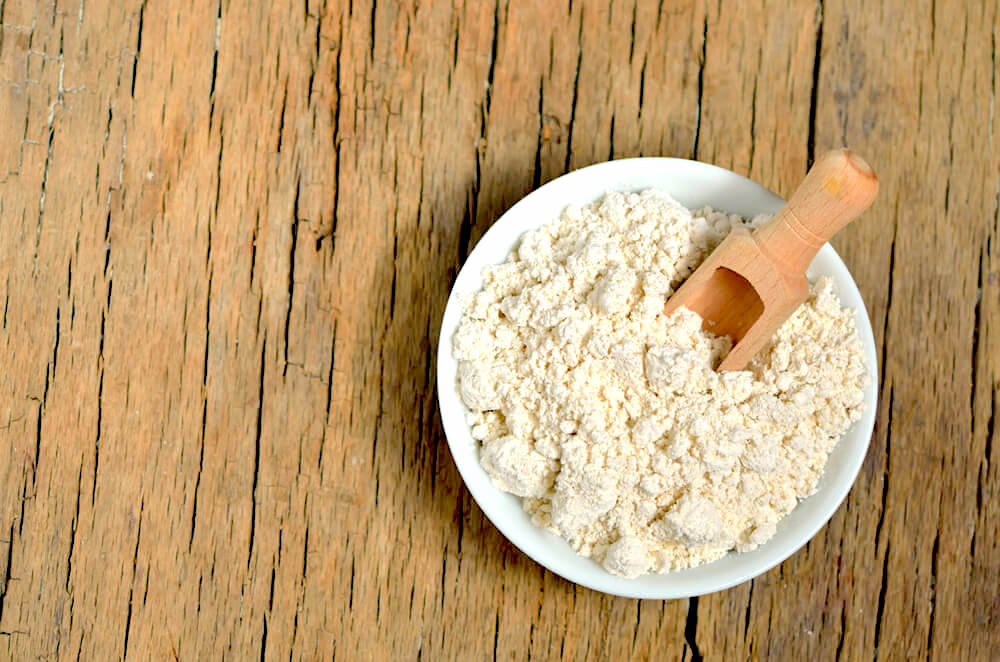Know The Difference Between Allergic and Irritant Dermatitis

Your skin acts as a shield, protecting your body from all of the damage that the environment can cause, with your outermost layer of skin doing this to the greatest extent.
However, sometimes things can go wrong…
Whether due to genetics or environmental factors, the skin’s protective barrier can often end up not functioning properly. This means that, instead of trapping in moisture and preventing allergens and irritants from coming into contact with the skin, it ends up releasing moisture and allowing these contaminants in.
The redness, soreness and inflammation that follow are referred to as contact dermatitis, of which there are two types; allergic and irritant.
What is Irritant Contact Dermatitis?
Irritant contact dermatitis is the most common form of contact dermatitis.
What causes it?
When your skin comes into contact with an irritating substance.
These vary in severity, with extreme irritants causing a reaction in just a few seconds, while mild irritants only cause a reaction after repeated contact. Whichever the case, if symptoms are going to arise, they will usually do so within 48 hours of coming into contact with an irritant.
On the other hand, for some people, a tolerance to those irritants can also be developed over time, therefore reducing symptoms.
Common irritants include:
- Rubbing alcohol
- Bleach and detergents
- Airborne substances, such as sawdust
- Plants
- Hair dyes
- Pesticides and weed killers
- Shampoos
- Rubber gloves
- Cement
What is Allergic Contact Dermatitis?
Allergic contact dermatitis occurs when your skin comes into contact with a substance that you are allergic to, therefore triggering an immune reaction. This reaction is usually concentrated to the area of skin that came into contact with the allergen.
Just like with irritant contact dermatitis, you can sometimes develop a tolerance for certain allergens. However, you can also develop new allergies, with even a small amount of the allergen resulting in a reaction.

Common allergens include:
- Nickel and other metals, found in everything from jewelry to buttons to lipstick holders
- Some plants, such as poison ivy and poison oak
- Adhesives, even those used for false eyelashes
- Certain fabrics, as well as their dyes
- Hair dyes, nail polishes and other cosmetics
- Airborne substances, such as pollen and insecticide sprays
- Some medications
Most people do not actually experience a reaction when they first come into contact with an allergen. Instead, it requires several more exposures for a reaction to occur, which can sometimes make it quite difficult to figure out exactly what is triggering your reaction.
Symptoms of Allergic and Irritant Contact Dermatitis
The symptoms for both allergic and irritant contact dermatitis are similar, and include:
- Redness
- Inflammation
- Blistering
- Dryness
- Thickened areas of skin
- Cracking
Additional symptoms from allergic contact dermatitis include itching, while irritant contact dermatitis can sometimes cause a stinging or burning sensation in the skin.

These symptoms can develop just about anywhere on the body, although they usually tend to show up on the hands and face.
While it isn’t common, sometimes the parts of the skin affected by contact dermatitis can become infected. If this happens, you will likely experience your existing symptoms rapidly worsening, and may also find a discharge coming from your skin, along with pain and feeling generally unwell.
Diagnosing Allergic and Irritant Contact Dermatitis
Since the symptoms for both irritant and allergic contact dermatitis are pretty much the same, this can lead to some challenges when it comes to diagnosing the condition.
Fortunately, many people are able to figure out themselves what their skin is reacting to, as the reactions can often occur quite soon after coming into contact with an allergen or irritant.
If you aren’t able to work this out, then it gets a bit trickier…
For allergic contact dermatitis, your dermatologist can perform a patch test.
What is a patch test?
It is when tiny amounts of different common allergens are applied to the skin using a special tape, and remain there for around two days. Once the patches are removed, your skin will then be immediately examined to check for reactions, and then examined again after two days, to check for any delayed reactions.
While this may seem like a great option, patch testing can not only be expensive, but has also shown to be only 70% to 80% accurate, meaning that you will not be able to fully trust the results.
Unfortunately, when it comes to irritant contact dermatitis, there are no tests available, as testing for irritants is notoriously unreliable.
However, there is one test that you can do yourself at home, especially when it comes to cosmetic products…
This is known as a repeated open application test, or ROAT.
It involves you applying the substance you want to test to the same area of skin twice a day, doing this for up to ten days. This gives you the chance to see how your skin reacts to the ingredients over time, and whether or not any irritants are present.
Avoiding Allergens and Irritants
When it comes to treating both forms of contact dermatitis, the only way to really clear your symptoms is by avoiding the allergen or irritant that caused them in the first place.
Of course, this is sometimes easier said than done…
The key here is to figure out what your allergens or irritants are, and then find ways in which you can prevent your skin from coming into contact with these.
For example, if you have to come into contact with your irritants as part of your job, you can start wearing gloves or other forms of protective clothing to ensure that those irritants do not have the opportunity to touch your skin.
How to Soothe Symptoms of Contact Dermatitis
Whether or not you are able to identify the allergen or irritant that has caused your skin to react, you will definitely need a few tricks up your sleeve when it comes to soothing your skin after a reaction.
The first step that you should take is to wash your skin well. While this may not make much of a difference for allergic contact dermatitis, it will help with irritant contact dermatitis, as you will be washing away any remnants of the irritant that have remained on your skin.
A cool compress can also really help to soothe your skin and calm inflammation. All you need to do is wrap a chilled or frozen item in a clean cloth, and then apply this to the affected area of skin.
Another option would be to apply a calamine lotion, which would treat any oozing, itching and redness.
If large areas of your skin have been affected, try taking a bath in some colloidal oatmeal. The oatmeal works by binding to your skin and forming a protective barrier, which not only reduces inflammation, but also helps your skin to hold moisture.

Wondering whether you can use the oatmeal you have in your kitchen instead?
No. This will not have the same effect at all. Colloidal oatmeal consists of oatmeal that has been very finely ground, and then boiled. Thanks to this process, colloidal oatmeal contains a higher amount of antioxidants, beta-glucan and starches, all of which give it its water-binding and skin-protecting properties.
Want an alternative to colloidal oatmeal?
Try Dead Sea salts instead. Studies have found that bathing in a Dead Sea salt solution can strengthen the skin’s natural barrier, reduce inflammation and improve hydration, all thanks to the high magnesium content of these salts.
Strengthening Your Skin’s Natural Barrier
As mentioned above, contact dermatitis only affects people who have an inefficient skin barrier.
This means that one of the best ways to prevent contact dermatitis from occurring in the first place is by strengthening your skin’s natural barrier, so that it can function to the best of its abilities, keeping allergens and irritants away from your skin.
How can you strengthen this barrier?
There are a few different ways…
The most immediately effective is by using an emollient.
What is an emollient?
They are ingredients that can fill in the gaps and cracks in your skin’s natural barrier, packing them with a fatty substance known as lipids to strengthen, soften and smooth the skin.
Emollients have three main properties:
- Humectant – humectants draw moisture from the air and hold them onto the skin, therefore helping to increase skin hydration and moisture content
- Occluder – occlusive ingredients coat the surface of the skin with a thin layer of oil, therefore slowing down moisture loss through evaporation
- Lubricant – a lubricant prevents friction from arising when the skin rubs against various surfaces, therefore preventing more damage from affecting the skin’s natural barrier
Emollients are available in a wide variety of products, with the best ones for contact dermatitis being:
- Ointments – these are thick and greasy, but are also the most moisturizing. The skin can’t properly absorb them so the remain on the surface of the skin and prevent water loss. Ointments also don’t usually contain preservatives, meaning that there is less of a chance that your skin will react to the ingredients within
- Creams – these are thinner than ointments, thanks to their balance of oil and water. They are good for using both day and night, but will need to be reapplied more often than an ointment
- Lotions – while these are easy to spread and quickly absorbed by the skin, they are the least moisturizing and also usually contain quite a few preservatives, meaning that they could actually lead to even more skin reactions
In addition to using emollients, there are many other ingredients out there that can help to strengthen your skin’s natural barrier.
Give some of the following a try:
- Hyaluronic Acid and Glycerin – these are both humectants that thicken the skin’s barrier and keep it hydrated
- Jojoba and Squalene – act as lubricants on the skin’s surface
- Ceramides – naturally found in the skin, these give structure and strength to the skin’s barrier, while also healing damaged skin cells
While topical products definitely help, there are other changes that you can make in your life to help support your skin’s protective barrier. Stress and a lack of sleep can both weaken the barrier, so make sure that you keep both of these to a minimum.
You can also try consuming a diet richer in omega-3 and omega-6 fatty acids, as well as antioxidants from fresh fruits and vegetables. Blueberries and blackberries are particularly beneficial, as these contain specific flavonoids that strengthen the skin’s connective tissues while reducing allergic reactions – something that is key for allergic contact dermatitis.
Finally, consuming more probiotics can also help. These will strengthen your immune system, which will therefore stimulate your skin’s barrier to work more effectively.
Stronger Treatments for Contact Dermatitis
If your allergic or irritant dermatitis is quite severe, there are a couple of different treatment options that your doctor might prescribe.
The first are topical corticosteroids, which are creams or ointments designed to be used topically. They vary in strength, and the one prescribed to you will depend on everything from the severity of your treatments to the part of your body affected.
Topical corticosteroids do sometimes cause short-term side effects, from acne to thinning skin, but will begin to work within a few days.
For cases of contact dermatitis that are even more severe, or cover large parts of the body, doctors may prescribe steroid tablets.
These can cause some serious side effects, so are only used as a last resort.
Both allergic and irritant contact dermatitis are extremely common, with around 15 million people in the USA experiencing a form of contact dermatitis each year. While this can definitely be a frustrating condition to deal with, there are many steps that you can take to reduce symptoms and flare-ups, keeping your skin as healthy and as happy as it can be.

